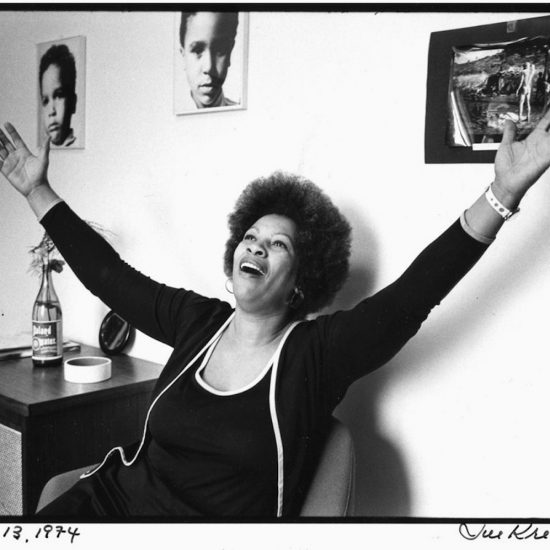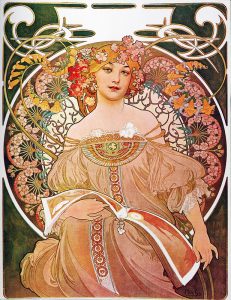She had just died, and I couldn’t stop looking at a photograph of her. She held me there: in her Random House office in 1974, outstretched arms, open palms, eyes cast upwards, mouth widening into a shape of jubilation. I do not know what she is reacting to in the picture, but I still can’t get over the way that ecstasy gathers on her face. My gaze cannot let go, for I am committed to looking at her with the kind of uncompromising affection with which she looked at Black life.
Five years ago, I was arrested by that image of Toni Morrison, captured by photographer Jill Krementz. She had passed the night before on August 5. We were all learning of her death the morning after, and a hollowness was growing in my stomach as the reality set in that there would be no more pages unfurling from the wideness of her imagination, no more of her pen loving and lingering on Black life in the way she did.
I return to Morrison’s writings — novels and non-fiction alike — several times a year. With each encounter, she gives me a new set of eyes and imbues my sight with deeper shades of Blackness. Morrison is salient always, but particularly so when I am looking. And looking is among the principal investments in my life as a writer responding to and thinking alongside artworks — for the most part, artworks by artists of the Black diaspora.
Almost a year after Morrison’s death, in that 2020 summer convulsing with Black protests and elegies, after the unrelenting tides of anti-Blackness had once again swelled with death and then with the futile promises of White guilt, a video of the writer — clipped from a 1998 interview with Charlie Rose — began circulating widely on the internet. She is majestic in leopard print as she speaks about how White people see — or cannot see — her writing. Rose had asked Morrison to respond (again) to a question that Bill Moyers had asked in an interview in 1990: Would she ever write a book that didn’t center Black people? Morrison had answered Moyers with a surefire “absolutely.” She elaborates in her interview with Rose that the problem was not that she couldn’t write such a book but rather Moyers’s question itself, for it was asked “as though our lives have no meaning and no depth without the White gaze.” Morrison goes on, emphasizing each word with a gesticulating hand: “And I have spent my entire writing life trying to make sure the White gaze was not the dominant one in any of my books.”
For that commitment, we can only be in excess of gratitude.

Morrison reminds all of us who are Black, reminds those of us who look and write in this art world — which, no matter how much it insists otherwise, remains almost preternaturally attached to the proclivities and demands of White people and institutions — of our responsibility. Namely, to dwell in Black visions, to give ourselves over to them entirely, and to do so in language that does not ask for permission or plead for understanding. The beating heart of conventional art writing — often delimited to interpretation and judgment — must take on a different rhythm if it is to take this charge seriously. By this, I do not mean that Black art writing should abandon critique. Rather, I mean that we ought to keep getting swept up in the complexity of the art and the vision, in the places where it intransigently resists interpretation, in the way that it moves and torques, and in the feeling of words dancing with it; that we heed its call for winding, wayward sentences that are often accused of being too poetic, as Morrison’s own writing often was. I relish this accusation.
In The Bluest Eye (1970) — Morrison’s book about gazes and a Black girl’s desire for a White girl’s blue eyes — Pecola Breedlove, the girl with black and “tight, tight eyes,” encounters a racist shopkeeper who refuses to fully see her. “Somewhere between retina and object, between vision and view, his eyes draw back, hesitate, and hover … he senses that he does not need to waste the effort of a glance,” Morrison writes. “He does not see her because there is nothing to see.”
There are no conditions for recognition in the shopkeeper’s gaze. So Morrison dedicates the entirety of The Bluest Eye to recognizing Pecola. If the shopkeeper rescinds his gaze, Morrison extends hers with full and attentive generosity, devotedly stretches it out over the expanse of Black life. She deals with it all — with the beauty and the poetry but also with Pecola Breedlove’s supposed ugliness, with Sethe’s ghosts in Beloved (1987), with the general accretion of hurt and violence that bleeds from her pages. Her principal endeavor is not to render an expression of these worlds that agrees with any judgment of the beautiful, but instead, to witness them.
This is also the work of Black art writing: to generate and expand the conditions wherein words can witness images and their makers, and we can witness one another, with completeness. The task is all the more urgent now, as the jaws of the art world voraciously consume Black art and aesthetics while holding the disturbed and bruised flesh of its underbelly at bay, and continuing to exclude people like Pecola. This kind of constrained hunger is accompanied by a gaze different from that of the shopkeeper who could not even glance at Pecola. But it is certainly not, in my view, a gaze that witnesses Black art in its depth and entirety.
Morrison’s literature was animated by her burning desire to give Blackness wings, to chart its path of flight from the asphyxiating hold of the White imagination, to look at Blackness in the places where it stands in this freedom. There is no shortage of what we can learn from her solicitude as we seek to narrativize visual forms that have been brought into the world by Black hands.




